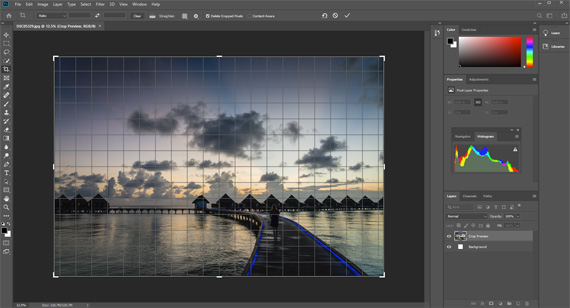Most people want to do special effects with Photoshop but like all tools capable of advanced work, it pays to get the essential basics under your belt first. Here is my recommended list of the 6 basic essentials any Photoshop beginner should learn:
1. Learn the image analysis tools – The Histogram, The Eyedropper, and The Info Palette
These three tools provide you with essential information about your image or photograph. The Histogram will tell you everything you need to know about the exposure of the photograph, whether it is under or over exposed, and the tonal range. The Eyedropper tool will give you valuable information about the colours in the image; especially if there is a colour cast (a colour cast is an undesirable overall dominant colour) you need to correct. The Info palette (or window) will provide numerical feedback when using the eyedropper and also when using other tools. This is an important reference for advanced work so is worth getting to know at the start.
2. Learn how to straighten a tilted image – Use the ruler to find the angle of tilt
Learning to use the Ruler tool will allow you to determine precisely the angle of a tilted horizon and this can then be used with the Rotate canvas command to rapidly correct a tilted image. No guesswork needed! With so many people using cameras with only viewing screens at the back rather than a proper viewfinder, it has become all to common for pictures to come out of the camera with a severe tilt to them. Learning to use the ruler and rotate canvas combination makes correcting these pictures really easy!
3. Learn to crop the picture – Use the Crop tool
Cropping is the process of removing anything from around the edges of a photo that does not add to the impact of the photo. The Crop tool should be learned next since cropping is a very important creative process. There are very few photos that cannot benefit from being cropped. Too many Photoshop beginners just accept the content of the photo as it came from the camera without thinking about whether the picture can be improved visually by cutting away unnecessary edges. The additional benefit of cropping the picture early is that you also reduce the file size which makes further changes to the image run much faster since you are using less memory and disk space.
4. Learn to remove dust marks and blemishes – Use the Healing Brush and the Clone Stamp tools
Even with modern sensor cleaning built-in, you may find your image contains dust marks or other blemishes. These will often be seen in areas of smooth tone such as a clear sky. These should be removed using the Healing Brush tool, especially useful on smooth colour and tones like skies, and the Clone Stamp tool. The Clone Stamp tool is essential for removing or correcting areas of detail which the Healing Brush tool quite often just messes up. Get a grip on these two important tools quickly so you can really clean up your important images.
5. Learn to correct the tonal values – Use the Levels command
The next logical step is to correct any exposure problems or tonal range issues. If the picture is too dark or light now is the time to correct it. To do tonal corrections you need to learn to use the Levels command. The levels command uses a histogram to show the tones so your previous learning from Step 1 above will really help you now. I told you it was a logical learning sequence!
6. Learn to remove colour casts – Use the Colour Balance command
Although modern cameras make a reasonable job of interpreting the colour of light reaching the sensor, they also often get it wrong which results in a photo with an obvious dominant colour. This is known as a colour cast and needs to be removed using the Colour Balance command. Once a dominant colour has been corrected you are ready to make more creative colour enhancements if desired.
There you have the six most important things for a Photoshop beginner to learn. Each of these steps can be mastered quite quickly and the knowledge gained will provide a solid foundation for all your future Photoshop work; whether you just want to improve a family snap or produce an advanced special effects work of art.
About the Author:
Les Meehan has authored seven Photoshop books and, as a qualified teacher, have run workshops for over 20 years.
Like This Article?
Don't Miss The Next One!
Join over 100,000 photographers of all experience levels who receive our free photography tips and articles to stay current:







Without some recommended documentation all these suggestions are useless!
Thanks for one marvelous posting! I really enjoyed reading it. It is nicely written and will bookmark your blog. Keep adding such great posts, thank again!
Seems most of these guidelines are applicable to using Lightroom as well, other than the clone stamp and Healing Brush (which are dreadful on Lightroom). Good tips, thanks….
Thank you its so helpful for me.
Exactly what most want to do, bypass all the basics and rush into the advanced . Please take your time just as the post advises to learn all the basic’s, then you will have a great platform or foundation to build your knowledge and new skills upon.
This is a great & informative post, thanks for the information, and I am looking forward to further posts.
Thank you for those very helpful suggestions. Photoshop seems overwhelming to me in many areas, but with those basic rules, it nows seems much more achieveable.
Just wish I’d come across this earleir!
Exactly what most want to do, bypass all the basics and rush into the advanced . Please take your time just as the post advises to learn all the basic’s, then you will have a great platform or foundation to build your knowledge and new skills upon.
This is a great & informative post, thanks for the information, and I am looking forward to further posts.
Allen Sentance Fisherman